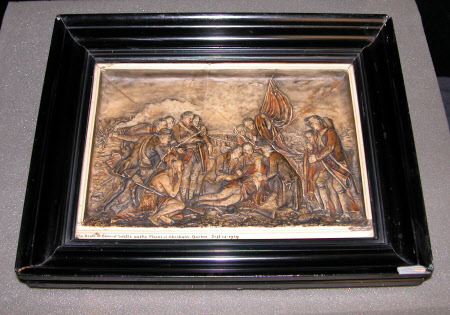The Death of General James Wolfe at Quebec (1727-1759)
after Benjamin West (Swarthmore, Pennsylvania 1738 - London 1820)
Category
Art / Sculpture
Date
c. 1780 - 1820
Materials
Wax
Measurements
190 x 267 x 65 mm
Place of origin
London
Order this imageCollection
Ickworth, Suffolk
NT 851480
Summary
Sculpture, wax; The Death of General James Wolfe (1727-1759); after Benjamin West (1738-1820); London, c. 1780-1820. A reduction in wax of the American painter Benjamin West’s celebrated painting depicting the death of General James Wolfe after the Battle of Quebec or the Battle of the Plains of Abraham, on 13 September 1759. This battle was a turning point in the struggle between Britain and France for control of North America, during the Seven Years War (1756-63). One of the full-size versions of this influential and controversial work is at Ickworth, which probably accounts for the presence in the collection of this small version in wax. Rather than being derived from the full-size painting, the wax relief may well have been based on William Woollett’s engraving, published in 1776.
Full description
A small reduction in wax of Benjamin West’s painting of the Death of General James Wolfe. In the centre Wolfe is seen dying in the arms of his officers, around them a circle of mourning figures, including at left a seated, pensive Native American man. In the distance, on the right, British troops may be seen disembarking from the St Lawrence River; at left, a running figure brings a French flag seized from the retreating enemy. An inscription at bottom. The white wax surface has been shaded or inked in to follow the contours of the design, to increase legibility and depth. Set within an ebonized wooden frame. The relief is severely cracked, with major cracks running from both top corners and the lower right corner. On the back, a printed label with a description of William Woollett’s engraving of West’s scene. The American born painter Benjamin West’s painting depicting the death of General James Wolfe (1727-1759) in the aftermath of his victory over French forces at the battle variously known as the Battle of Quebec or the Battle of the Plains of Abraham, was the first work that the painter sent to public exhibition, at the Royal Academy in 1771. An immediate huge public success, it is now recognized as one of the most influential history paintings of the eighteenth century, even though West took considerable liberties with his staging, not least the conscious way in which the dying man, Britain’s first imperial hero, was depicted almost in the guise of a Christian martyr. The first version of the painting is now in the National Gallery of Canada (Erffa and Stanley 1986, no. 93), but West painted several other versions, including one commissioned probably by the 4th Marquess of Bristol, the Earl Bishop (1730-1803) in 1779, which is today at Ickworth (NT 851873; Erffa and Stanley 1986, no.96). Apart from the merits of the composition, the 4th Earl might have wanted a version of the painting because his younger brother General William Hervey (1732-1815) may well have been present at the Battle of Quebec. He served in North America in the campaigns against the French from the time of his commissioning in 1755, until his return to Britain in 1763. Hervey was certainly present at the Siege of Fort Niagara in the summer of 1759 and may well have been at the Battle of Quebec in September, although this is not certain. In addition, General Wolfe's aide-de-camp Captain Sir Hervey Smythe (1734-1811), shown in the painting kneeling at the General’s side, was a grandson of the 1st Earl of Bristol and thus a cousin to the Herveys. The basis for this rather pedestrian copy of the composition was probably not one of West’s paintings, but William Woollett’s highly accurate and immensely successful engraving made from the prime version of the painting, and published on 1 January 1776. The printed label on the back is a description of the print from a dealer’s catalogue. Jeremy Warren July 2025
Provenance
The Bristol Collection; acquired through the National Land Fund and transferred to The National Trust in 1956.
Makers and roles
after Benjamin West (Swarthmore, Pennsylvania 1738 - London 1820), painter
References
Von Erffa & Staley 1986 Helmut von Erffa & Allen Staley, The Paintings of Benjamin West, New Haven & London 1986

